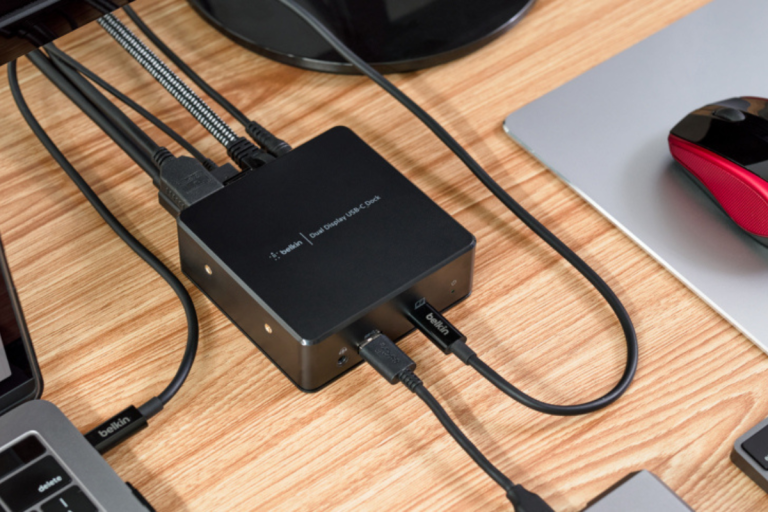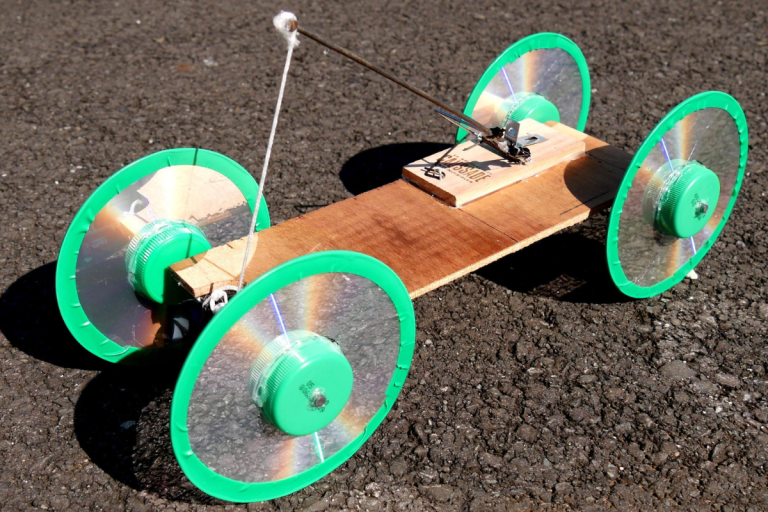5 The best mouse for gaming
The best mouse for your laptop can be a game-changer. Whether you’re tired of your laptop’s trackpad or want a smoother experience, the right mouse makes all the difference. Some are sleek and portable, perfect for your on-the-go lifestyle. Others are packed with features that make work and play easier.
5. The best mouse for gaming
| Product Name | Check Price | |
| 1 | Logitech MX Master 3S | Check Price |
| 2 | Microsoft Bluetooth Ergonomic Mouse | Check Price |
| 3 | Razer Atheris | Check Price |
| 4 | Apple Magic Mouse 2 | Check Price |
| 5 | Anker Vertical Ergonomic Optical Mouse | Check Price |
1. Logitech MX Master 3S
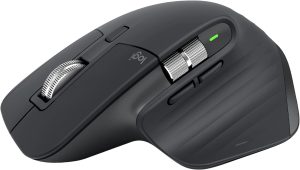
| Feature | Details |
| DPI Sensor | 8000 DPI, customizable sensitivity |
| Quiet Clicks | 90% less click noise |
| Scrolling | MagSpeed, ultra-fast and precise |
| Ergonomic Design | Natural wrist posture, thumb controls |
| Connectivity | Bluetooth and Logi Bolt USB receiver |
| Multi-device Control | Connect up to 3 devices, cross-platform |
The best mouse for your laptop. The Logitech MX Master 3S. I’ve spent a lot of time with this mouse, and it’s impressive in many ways.
The 8000 DPI sensor is fantastic. Whether you’re working on glass, a wooden desk, or even your jeans, this mouse tracks smoothly everywhere. You can also adjust the sensitivity to suit your needs, which is a big win for precise tasks and rapid movements.
The Quiet Clicks are a game-changer. If you’ve ever been annoyed by loud clicking sounds, you’ll appreciate how the MX Master 3S keeps things whisper-quiet without losing that satisfying click feel.
Scrolling with the MagSpeed wheel is almost magical. It’s not just fast and precise, it’s also super quiet. I can fly through long documents or web pages in a snap, and it stops exactly where I want it to.
Comfort is key, and this mouse nails it with its ergonomic design. It’s shaped perfectly for my hand, and the thumb controls are where they should be. It feels natural, reducing wrist strain during long hours of work.
Switching between devices is seamless. I can connect up to three devices and switch between them with a simple button press. It works across Windows, macOS, and even incredibly versatile Linux.
The Logi Options+ app adds another layer of customization, letting me tailor the buttons and create profiles for different applications. It’s great for streamlining my workflow and saving time.
Pros:
- Smooth tracking on any surface
- Super quiet clicks
- Fast and precise scrolling
- Comfortable for long use
- Seamlessly connects to multiple devices
Cons:
- Premium price
- Might be a bit bulky for smaller hands
2. Microsoft Bluetooth Ergonomic Mouse
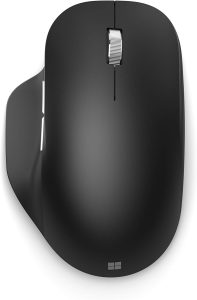
| Feature | Details |
| Ergonomic Design | Natural hand and wrist position, thumb rest |
| Tracking Sensor | Precise, works on various surfaces |
| Scroll Wheel | Machined aluminum, precise navigation |
| Build | Lightweight, durable, premium materials |
| Customizable Buttons | 3 buttons, app-specific functions |
| Connectivity | Bluetooth, seamless connection |
The best mouse for your laptop, the Microsoft Bluetooth Ergonomic Mouse might just be the perfect fit. After using it extensively, here’s why it stands out. First off, this mouse feels incredibly comfortable.
Its ergonomic design supports my hand and wrist naturally, reducing strain even during long work sessions. The thumb rest is soft and easy to grip, making it a joy to use for hours on end. The tracking sensor is impressive.
It’s precise and glides smoothly over various surfaces, from my desk to my couch. This is thanks to the Teflon base, which ensures smooth movement without any hiccups.
Navigating through documents or websites is a breeze with the machined aluminum scroll wheel. It offers precise control, and the tactile feel makes scrolling through long pages satisfying.
This mouse is also built to last. It’s lightweight yet durable, with a seamless finish that feels premium. The materials used are top-notch, and it looks sleek on my desk.
I love the three customizable buttons. They let me set up specific functions for different apps, which boosts my productivity. Whether I’m editing photos or browsing the web, having quick access to my most-used commands is super handy.
Connecting via Bluetooth is seamless. I don’t have to deal with any dongles or wires, and it pairs quickly with my laptop.
Pros:
- Comfortable and ergonomic
- Smooth and precise tracking
- High-quality build and materials
- Customizable buttons for better productivity
- Easy Bluetooth connectivity
Cons:
- Limited to three customizable buttons
- May feel small for larger hands
3. Razer Atheris
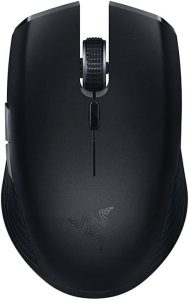
| Feature | Details |
| DPI Sensor | 7200 DPI, adjustable sensitivity |
| Battery Life | Up to 350 hours with 2x AA batteries |
| Connectivity | 2.4 GHz Wireless & Bluetooth Low-Energy |
| Scroll Wheel | Ridged, rubberized for maximum accuracy |
| Programmable Buttons | 5 buttons, customizable via Razer Synapse 3 |
| Switches | Durable, supports up to 50 million clicks |
The best mouse for your laptop that combines performance, portability, and style? The Razer Atheris could be exactly what you need. After testing this compact beast, I’ve got plenty to share.
The first thing I noticed is the 7200 DPI optical sensor. It’s incredibly precise and perfect for both casual browsing and intense gaming. Adjusting the sensitivity on the fly is a breeze, and the 1000 Hz ultrapolling ensures every move is lightning fast and accurate.
Battery life is where the Atheris shines. With up to 350 hours on two AA batteries, I don’t worry about running out of power anytime soon. Whether I’m working, gaming, or traveling, it keeps going without a hitch.
Connectivity is versatile and reliable. It switches seamlessly between 2.4 GHz wireless and Bluetooth Low-Energy, ensuring a lag-free experience. The Adaptive Frequency Technology is a smart touch, that automatically finds the best connection.
The ridged, rubberized scroll wheel offers precise control with a satisfying feel. Those tiny tactile bumps make scrolling more controlled and accurate, which is crucial in fast-paced gaming or detailed work.
Customization is key with the five programmable buttons. Using Razer Synapse 3, I’ve tailored them to my needs, mapping different functions for different apps. It’s like having shortcuts right at my fingertips.
Durability is another highlight. The mechanical switches are rated for up to 50 million clicks, so I know this mouse will last me through countless projects and games.
Pros:
- High precision and adjustable sensitivity
- Long battery life
- Reliable wireless and Bluetooth connections
- Customizable buttons for personalized control
- Durable build for extended use
Cons:
- Uses AA batteries, not rechargeable
- Smaller size might not be comfortable for larger hands
4. Apple Magic Mouse 2

| Feature | Details |
| Power Source | Rechargeable built-in battery |
| Design | Lightweight, continuous bottom shell |
| Foot Design | Optimized for smooth tracking |
| Multi-Touch Surface | Gestures for swiping and scrolling |
| Compatibility | Mac devices |
| Connectivity | Bluetooth |
The Magic Mouse 2 lives up to its reputation as a sleek and functional accessory for Mac users. Its biggest advantage lies in the rechargeable built-in battery, which eliminates the hassle of traditional batteries. This feature alone makes it a sustainable and convenient choice, ensuring I never have to worry about running out of power unexpectedly.
In terms of design, the mouse is exceptionally lightweight with a smooth, continuous bottom shell. This streamlined construction, coupled with an optimized foot design, allows the Magic Mouse 2 to glide effortlessly across any surface with minimal resistance. Whether I’m working on a desk or a coffee table, the tracking is consistently smooth and responsive.
The Multi-Touch surface is where this mouse truly shines. It enables intuitive gestures like swiping between web pages and scrolling through documents with a simple flick of the finger. These gestures feel natural and seamless, enhancing my workflow and productivity without the need for extra buttons or controls.
Setting up the Magic Mouse 2 is a breeze—it’s ready to go right out of the box and pairs automatically with my Mac. This seamless integration ensures a hassle-free experience from the moment I start using it.
Pros:
- Rechargeable built-in battery eliminates the need for traditional batteries
- Lightweight design with smooth tracking
- Multi-touch surface for intuitive gestures
- Easy setup and automatic pairing with Mac
Cons:
- Designed specifically for Mac, limiting compatibility with other devices
- The lack of physical buttons may not suit users needing additional controls
5. Anker Wireless Vertical Ergonomic Optical Mouse
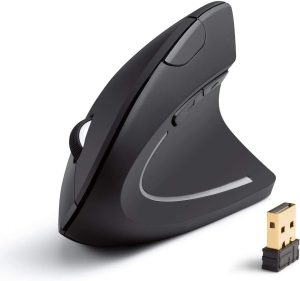
| Feature | Details |
| Ergonomic Design | Vertical “handshake” position, reduces strain |
| DPI Settings | 800 / 1200 / 1600 DPI, adjustable |
| Tracking Technology | Optical, precise on various surfaces |
| Additional Buttons | Next/Previous for easier web browsing |
| Power Saving Mode | Enters sleep mode after 8 minutes of inactivity |
| Dimensions and Weight | 120 x 62.8 x 74.8 mm, 3.4 oz |
The hunt for the best mouse for your laptop, the Anker Wireless Vertical Ergonomic Optical Mouse is worth a closer look. I’ve spent a lot of time using it, and here’s why it stands out.
The first thing you notice is its vertical design. It’s like a handshake – comfortable and natural. My wrist and arm feel less strained even after hours of use, which is a huge plus if you spend a lot of time at your computer.
This mouse offers adjustable DPI settings: 800, 1200, and 1600. Switching between these settings is simple, letting me choose the right sensitivity for different tasks, whether I’m browsing the web or working on detailed projects.
The optical tracking technology is top-notch. It’s precise and works smoothly on a variety of surfaces, so I don’t need a mouse pad. Whether I’m at my desk or using it on the go, it performs consistently well.
Navigating through web pages is a breeze with the added next and previous buttons. They’re conveniently placed and make flipping through online content faster and easier, which is great for internet surfers and gamers alike.
One clever feature is the power-saving mode. The mouse automatically goes to sleep after 8 minutes of inactivity. A quick click wakes it up, saving battery life without any hassle.
It’s also lightweight and compact, making it easy to toss in my laptop bag. It comes with a 2.4G USB receiver tucked neatly in the bottom, and the setup is straightforward.
Pros:
- Comfortable, ergonomic design reduces wrist strain
- Adjustable DPI for precise tracking
- Easy navigation with next/previous buttons
- Power-saving mode conserves battery
- Lightweight and portable
Cons:
- Vertical design may take some getting used to
- Requires AAA batteries (not included)
- Vertical design may take some getting used to initially
Buying Guide: 6 Factors to Consider When Choosing the Best Mouse for Your Laptop
The best mouse for your laptop about picking the most popular model it’s about finding the right fit for your specific needs and preferences. Whether you’re a student, a gamer, or a professional, the right mouse can significantly enhance your productivity and comfort. Here’s a comprehensive guide to help you make an informed decision based on key factors.
1. Ergonomics: Prioritize Comfort
Ergonomics should be your first consideration. A comfortable mouse reduces strain on your hand and wrist, especially during long hours of use.
- Ergonomic Designs: Look for mice with contours that fit the natural curves of your hand. Options like the Anker Vertical Ergonomic Mouse promote a neutral wrist position, minimizing discomfort.
- Hand Size: Consider the size of your hand. Larger hands may find full-size mice more comfortable, while smaller hands might prefer more compact models.
2. DPI and Sensitivity: Precision Matters
DPI (Dots Per Inch) determines how sensitive the mouse is to movement. Higher DPI settings provide smoother cursor control, essential for tasks like graphic design or gaming.
- Adjustable DPI: Opt for a mouse with adjustable DPI settings if you need versatility. The Razer Atheris offers on-the-fly DPI adjustment, allowing you to switch between sensitivity levels easily.
- Usage Scenario: Determine your typical tasks. A higher DPI is beneficial for detailed work, while a lower DPI might suffice for general browsing.
3. Connectivity: Wired vs. Wireless
Consider how you prefer to connect your mouse to your laptop. Each type has its pros and cons.
- Wired Mice: Provide a stable connection and don’t require battery changes. They’re ideal for gaming or tasks that demand zero latency.
- Wireless Mice: Offer freedom of movement and are more convenient for travel. Choose between Bluetooth or USB receivers based on your laptop’s connectivity options.
4. Battery Life: Longevity Matters
For wireless mice, battery life is crucial to uninterrupted use. Evaluate how often you use your laptop and how frequently you’re willing to change or recharge batteries.
- Battery Type: Consider whether the mouse uses replaceable batteries or has a rechargeable built-in battery.
- Usage Habits: If you work long hours or travel frequently, opt for a mouse with extended battery life like the Razer Atheris, which boasts up to 350 hours with AA batteries.
5. Customizable Features: Tailor Your Experience
Extra buttons and programmable features can enhance productivity by allowing you to customize shortcuts and commands.
- Programmable Buttons: Look for mice with programmable buttons if you need shortcuts for specific tasks. The Logitech MX Master 3S, for example, offers customizable buttons for personalized control.
- Software Compatibility: Ensure the mouse’s customization software is compatible with your operating system and applications.
6. Size and Design: Personal Preference
Consider the physical dimensions and design aesthetics of the mouse. It should feel comfortable and complement your workspace.
- Size: Choose a mouse that fits comfortably in your hand. Full-size mice offer more palm support, while smaller mice are more portable.
- Aesthetic: Select a design that matches your style preferences, whether it’s sleek and modern or ergonomic and functional.
FAQs
1. What is DPI, and why does it matter in a laptop mouse?
DPI (Dots Per Inch) measures sensitivity. A higher DPI means the cursor moves further with less physical movement. It’s crucial for tasks requiring precision, like design work or gaming.
2. What’s the difference between Bluetooth and USB receivers for wireless mice?
Bluetooth mice connect directly to your laptop without needing a USB port, while mice with USB receivers offer a dedicated, stable connection. Both have their advantages: Bluetooth for convenience, and USB for reliability in crowded wireless environments.
3. How do I know if an ergonomic mouse is right for me?
Ergonomic mice are designed to reduce strain on your hand and wrist. If you experience discomfort with traditional mice, switching to an ergonomic design like the Anker Vertical Ergonomic Mouse can provide relief and improve comfort during long sessions.
4. What should I look for in terms of battery life for a wireless mouse?
Battery life varies between models. Look for mice with long-lasting batteries or rechargeable options. For example, the Razer Atheris offers up to 350 hours of battery life with AA batteries, ideal for extended use without frequent recharging.
5. Are programmable buttons necessary in a laptop mouse?
Programmable buttons allow customization for specific tasks or applications, enhancing productivity. While not essential, they can streamline workflow by providing quick access to functions like copy-paste or media controls.
Conclusion
The best mouse for your laptop boils down to understanding your own needs and preferences. Whether you prioritize comfort with an ergonomic design, precision with adjustable DPI settings, or convenience with wireless connectivity, there’s a mouse out there to suit every user.
